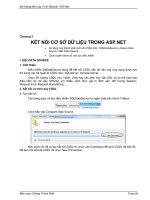Lecture E-Commerce - Chapter 22: ASP NET (part i)
Bạn đang xem bản rút gọn của tài liệu. Xem và tải ngay bản đầy đủ của tài liệu tại đây (456.53 KB, 63 trang )
CSC 330 E-Commerce
Teacher
Ahmed Mumtaz Mustehsan
GM-IT CIIT Islamabad
Virtual Campus, CIIT
COMSATS Institute of Information Technology
T2-Lecture-1
ASP.NET
Part - I
For Lecture Material/Slides Thanks to: www.w3schools.com
Introduction
Introduction
ASP.NET
is a development framework for building web
pages and web sites with HTML, CSS, JavaScript and
server scripting.
ASP.NET supports three different development models:
◦Web Pages,
◦Web Forms.
◦MVC (Model View Controller),
T2-Lecture-11
Ahmed Mumtaz Mustehsan
www.w3schools.com
1-4
Web Pages: Single Pages Model
Simplest ASP.NET
model.
Similar to PHP and classic ASP.
Built-in templates and helpers for database, video,
graphics, social media and more.
T2-Lecture-11
Ahmed Mumtaz Mustehsan
www.w3schools.com
1-5
MVC: Model View Controller
MVC
separates web applications into 3 different
components:
◦Models for data
◦Views for display
◦Controllers for input
T2-Lecture-11
Ahmed Mumtaz Mustehsan
www.w3schools.com
1-6
Web Forms: Event Driven Model
The
traditional ASP.NET event driven development
model:
Web pages with added server controls, server events,
and server code.
T2-Lecture-11
Ahmed Mumtaz Mustehsan
www.w3schools.com
1-7
Classic ASP
Classic ASP - Active Server Pages
Active Server Pages (ASP), also known as Classic
ASP, was introduced in 1998 as Microsoft's first server
side scripting engine.
ASP is a technology that enables scripts in web pages
to be executed by an Internet server.
ASP pages have the file extension .asp, and are
normally written in VBScript.
T2-Lecture-11
Ahmed Mumtaz Mustehsan
www.w3schools.com
1-8
ASP.NET
ASP.NET
is a new ASP generation. It is not compatible
with Classic ASP, but ASP.NET may include Classic
ASP.
ASP.NET pages are compiled, which makes them
faster than Classic ASP.
ASP.NET has better language support, a large set of
user controls, XML-based components, and integrated
user authentication.
ASP.NET pages have the extension .aspx, and are
normally written in VB (Visual Basic) or C# (C sharp).
T2-Lecture-11
Ahmed Mumtaz Mustehsan
www.w3schools.com
1-9
ASP.NET
User
controls in ASP.NET can be written in different
languages, including C++ and Java.
When a browser requests an ASP.NET file, the
ASP.NET engine reads the file, compiles and executes
the scripts in the file, and returns the result to the
browser as plain HTML.
T2-Lecture-11
Ahmed Mumtaz Mustehsan
www.w3schools.com
110
ASP.NET Razor
Razor
is a new and simple markup syntax for
embedding server code into ASP.NET web pages,
much like Classic ASP.
Razor has the power of traditional ASP.NET, but is
easier to use and easier to learn.
T2-Lecture-11
Ahmed Mumtaz Mustehsan
www.w3schools.com
111
ASP.NET Programming Languages
ASP Programming Languages that we will discuss:
Visual Basic (VB.NET)
C# (Pronounced C sharp)
T2-Lecture-11
Ahmed Mumtaz Mustehsan
www.w3schools.com
112
ASP.NET Development Options (methods)
ASP.NET
is a development framework for building web
pages and web sites with HTML, CSS, JavaScript and
server scripting.
ASP.NET supports three different Server Development
Technologies / Platforms:
1. Web Pages (with Razor syntax)
2. MVC (Model View Controller)
3. Web Forms
T2-Lecture-11
Ahmed Mumtaz Mustehsan
www.w3schools.com
113
ASP.NET Development Tools
ASP.NET
supports the following development tools:
1. WebMatrix
2. Visual Web Developer
3. Visual Studio
Note:
To learn ASP.NET MVC, we will Build an Internet
Application using Visual Web developer
T2-Lecture-11
Ahmed Mumtaz Mustehsan
www.w3schools.com
114
ASP.NET File Extensions
Classic ASP
files have the file extension .asp
ASP.NET files have the file extension .aspx
ASP.NET files with Razor C# syntax have the file
extension .cshtml
ASP.NET files with Razor VB syntax have the file
extension .vbhtml
T2-Lecture-11
Ahmed Mumtaz Mustehsan
www.w3schools.com
115
ASP.NET
Development Tools
Razor
Synopsis
Razor
Intro
Razor Syntax
Razor C# Variables
Razor C# Loops
Razor C# Logic
Razor VB variables, operator different from C#
Razor VB Logic (Select statement)
T2-Lecture-14
Ahmed Mumtaz Mustehsan
www.w3schools.com
117
Razor Intro
ASP.NET Razor - Markup
Razor
is not a programming language. It's a server side
markup language.
Razor is a markup syntax that lets you embed serverbased code (Visual Basic and C#) into web pages.
Server-based code can create dynamic web content on
the fly, while a web page is written to the browser.
When a web page is called, the server executes the
server-based code inside the page before it returns the
page to the browser.
By running on the server, the code can perform complex
tasks, like accessing databases.
Razor is based on ASP.NET, and designed for creating
web applications.
It has the power of traditional ASP.NET markup, but it is
1easier toAhmed
use,
and easierwww.w3schools.com
to learn.
T2-Lecture-14
Mumtaz Mustehsan
19
Razor intro
Razor uses a syntax very similar to PHP and Classic ASP.
Razor:
<ul>
@for (int i = 0; i < 10; i++) {
<li>@i</li>
}
</ul>
PHP:
<ul>
for ($i = 0; $i < 10; $i++) {
echo("<li>$i</li>");
}
?>
</ul>
T2-Lecture-14
Ahmed Mumtaz Mustehsan
www.w3schools.com
120
Razor intro
Web Forms (and Classic ASP):
<ul>
<% for (int i = 0; i < 10; i++) { %>
<li><% =i %></li>
<% } %>
</ul>
T2-Lecture-14
Ahmed Mumtaz Mustehsan
www.w3schools.com
121
Razor Helpers
ASP.NET helpers are components that can be accessed by
single lines of Razor code.
You can build your own helpers using Razor syntax, or use
built-in ASP.NET helpers.
Below is a short description of some useful Razor helpers:
◦ Web Grid
◦ Web Graphics
◦ Google Analytics
◦ Facebook Integration
◦ Twitter Integration
◦ Sending Email
◦ Validation
T2-Lecture-14
Ahmed Mumtaz Mustehsan
www.w3schools.com
122
Razor Programming Languages
Razor
supports both C# (C sharp) and VB (Visual
Basic).
T2-Lecture-14
Ahmed Mumtaz Mustehsan
www.w3schools.com
123
Razor Syntax
Main Razor Syntax Rules for C#
Razor
code blocks are enclosed in @{ ... }
Inline expressions (variables / functions) start with @
Code statements end with semicolon ( ; )
Variables are declared with the var keyword
Strings are enclosed with quotation marks
C# code is case sensitive
C# files have the extension .cshtml
T2-Lecture-11
Ahmed Mumtaz Mustehsan
www.w3schools.com
125









